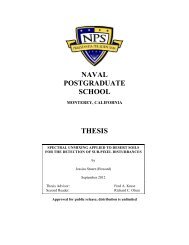October 2000 Newsletter - Naval Postgraduate School
October 2000 Newsletter - Naval Postgraduate School
October 2000 Newsletter - Naval Postgraduate School
You also want an ePaper? Increase the reach of your titles
YUMPU automatically turns print PDFs into web optimized ePapers that Google loves.
Professor Alan Ross, the Navy TENCAP Chair Professor, has<br />
studied soft errors in microprocessors and space systems.<br />
Associate Professors John Ciezki and Robert Ashton, Department<br />
of Electrical and Computer Engineering, have examined<br />
radiation effects in power devices and circuits, and Assistant<br />
Professor Todd Weatherford has examined solid state<br />
transistor modeling and material manufacturing issues.<br />
The radiation facilities at NPS are unique. The LINAC<br />
provides an electron beam pulse train of 100 MeV electrons<br />
(up to 1000 rads per microsecond pulse) useful for studying<br />
displacement damage in microelectronics or solar cells for<br />
applications in the Van Allen belts and even Jupiter’s radiation<br />
belts. This is the only LINAC in operation that produces<br />
electrons in the 100 MeV energy range. The facility<br />
can also be used to study both Total Dose and some weapons<br />
effects. The Flash X-ray facility produces a gamma pulse of<br />
100 rads in approximately 10-20 nanoseconds to simulate a<br />
weapons effect.<br />
Both facilities are available to NPS faculty and outside<br />
users for periods of one month at a time, with up to 80<br />
hours of “beam time” in a month. Charges are $2500/month<br />
for faculty and $9000/month for outside users.<br />
As mentioned earlier, the availability of thesis students<br />
with clearance provides an advantage with many of the<br />
projects that are classified or limited to U.S. citizens. Addi-<br />
RESEARCH CENTER<br />
RAD-HARD SEMICONDUCTOR CHIPS, continued from page 16<br />
THE “LINAC,”continued from page 16<br />
The realization of the NPS LINAC is shown in<br />
Figure 1, where each of three high power klystrons<br />
deliver power to one ten foot accelerator section. The<br />
klystrons require a high voltage high current source,<br />
called a modulator in the diagram. The electron beam<br />
is deflected by magnets to the experiment area. The<br />
energy of the electron beam is expressed in electron<br />
volts, one eV is the energy of an electron accelerated by<br />
one volt. Each 10-foot section gives energy of 30<br />
million electron volts, i.e. 30 MeV per section. An<br />
advantage of the LINAC concept is that higher energy<br />
is obtained by having more accelerator sections. The<br />
NPS LINAC yields about 100 MeV from 3 sections,<br />
the Stanford Mark 3 accelerator yielded 1000 MeV<br />
from 30sections, while the 960 section, 2 mile long<br />
Stanford Linear Accelerator Center (SLAC) accelerator<br />
yielded 20,000 MeV before the several upgrades.<br />
--continued on page 49<br />
tionally the NPS students are familiar with the satellite or<br />
weapon programs in which the research supports. Most<br />
student research has been involved in collaborations with<br />
industry such as; Motorola, Honeywell, Lockheed-Martin,<br />
Hughes, TRW, Vitesse Semiconductor, universities; UC<br />
--continued on page 49<br />
The Flash X-ray facility shown opened for maintenance.<br />
X-rays are produced in an adjacent room after 1,200,000<br />
volts are discharged from the capacitor banks shown inside<br />
the oil chamber.<br />
Figure 1. Design of NPS Linear Accelerator.<br />
NPS Research page 17<br />
<strong>October</strong> <strong>2000</strong>
















